Ielts Academic Reading Sample 105
A. Music has probably existed for as long as man has been human, and it certainly predates civilization by tens of millenia. Yet even today there is no clear definition of exactly what music is. For example, birdsong is certainly melodic, but it is not tuneful, and it is not created with the intention of being musical (in fact it is sometimes meant to sound threatening) - therefore does it count as music?
B.
B. On the other hand, some modern composers have been challenging the idea that music should be arranged in a pleasant manner with the notes falling in an orderly succession. Others, famously the avant guarde composer John Cage have even used silence and called the result music. As a result there is no one definition of music. Perhaps it should be said that music, like beauty, is what the person who sees or hears it believes it to be.
C.
C. Music is divided in many ways. Music itself is split into notes, clefts, quavers, and semi-demi quavers. Ancient and medieval musicologists believed that these notes could be arranged 'horizontally' into melody (making notes that match on the same scale) and 'vertically' (going up and down the scales to create harmony). Another very basic measurement of music is the 'pulse'. This is present in almost all forms of music, and is particularly strong in modern popular music. The pulse is the regular beat which runs through a tune. When you tap your foot or clap your hands in time to a song, you are beating out the pulse of that song.
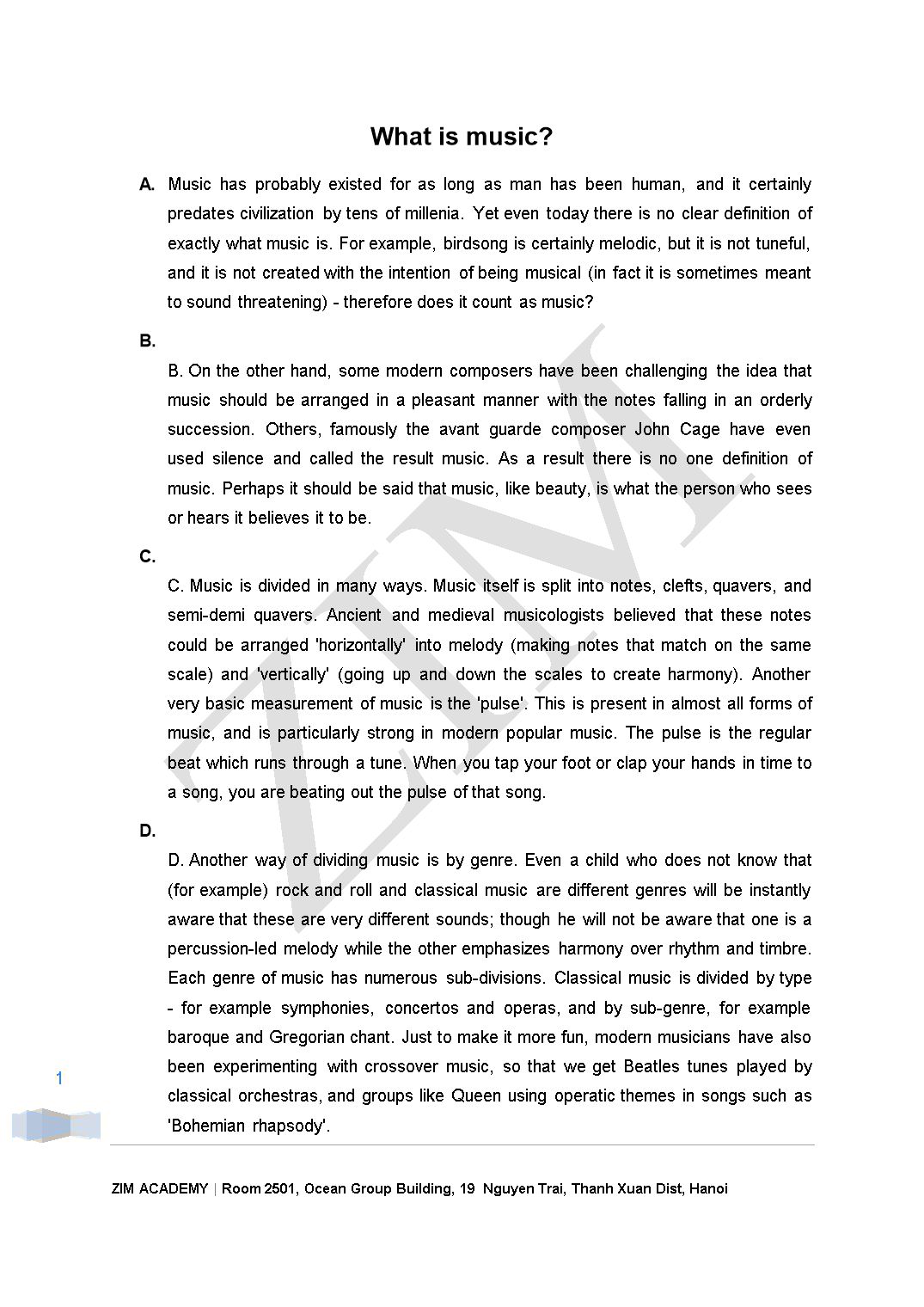
Trang 1
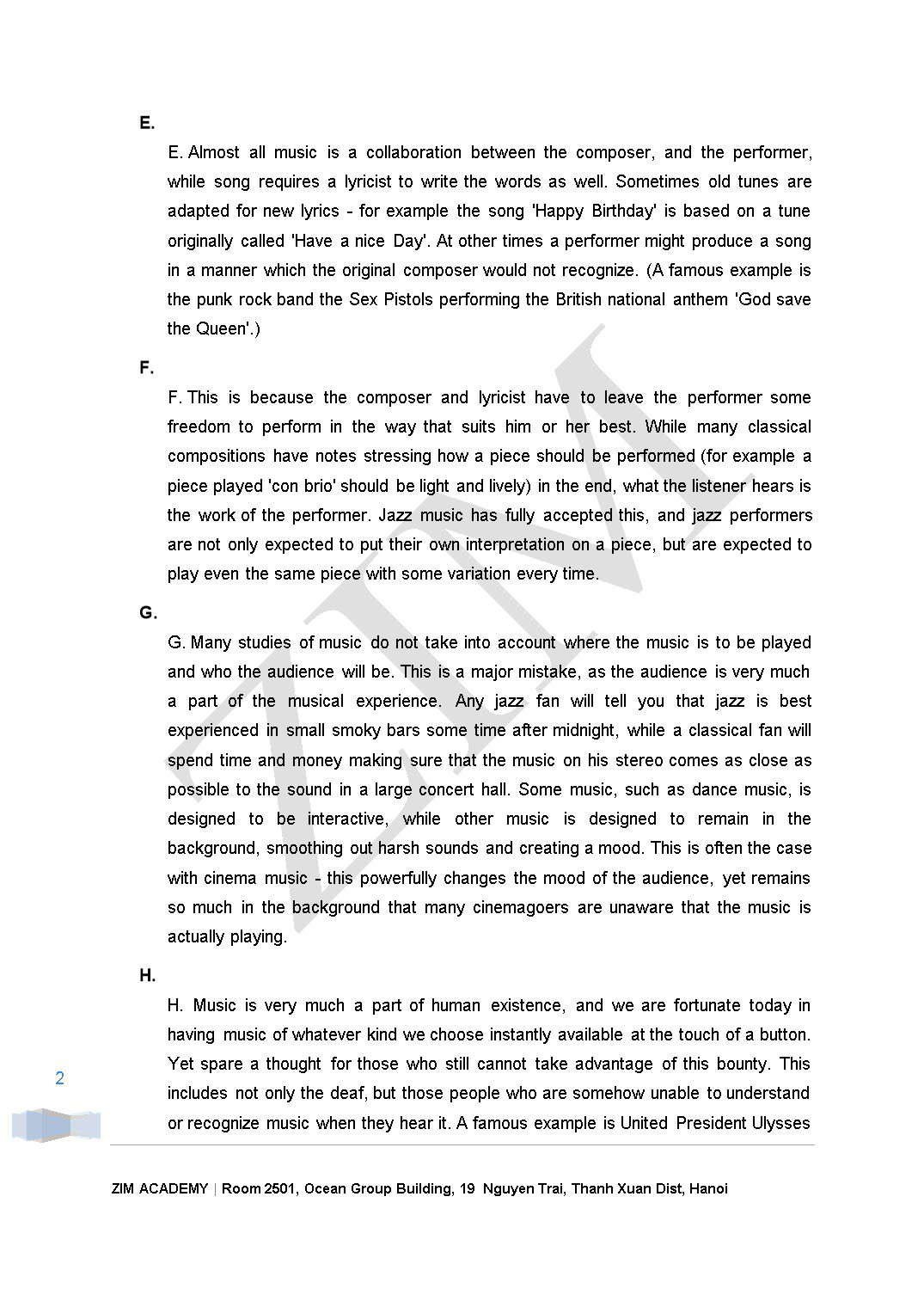
Trang 2
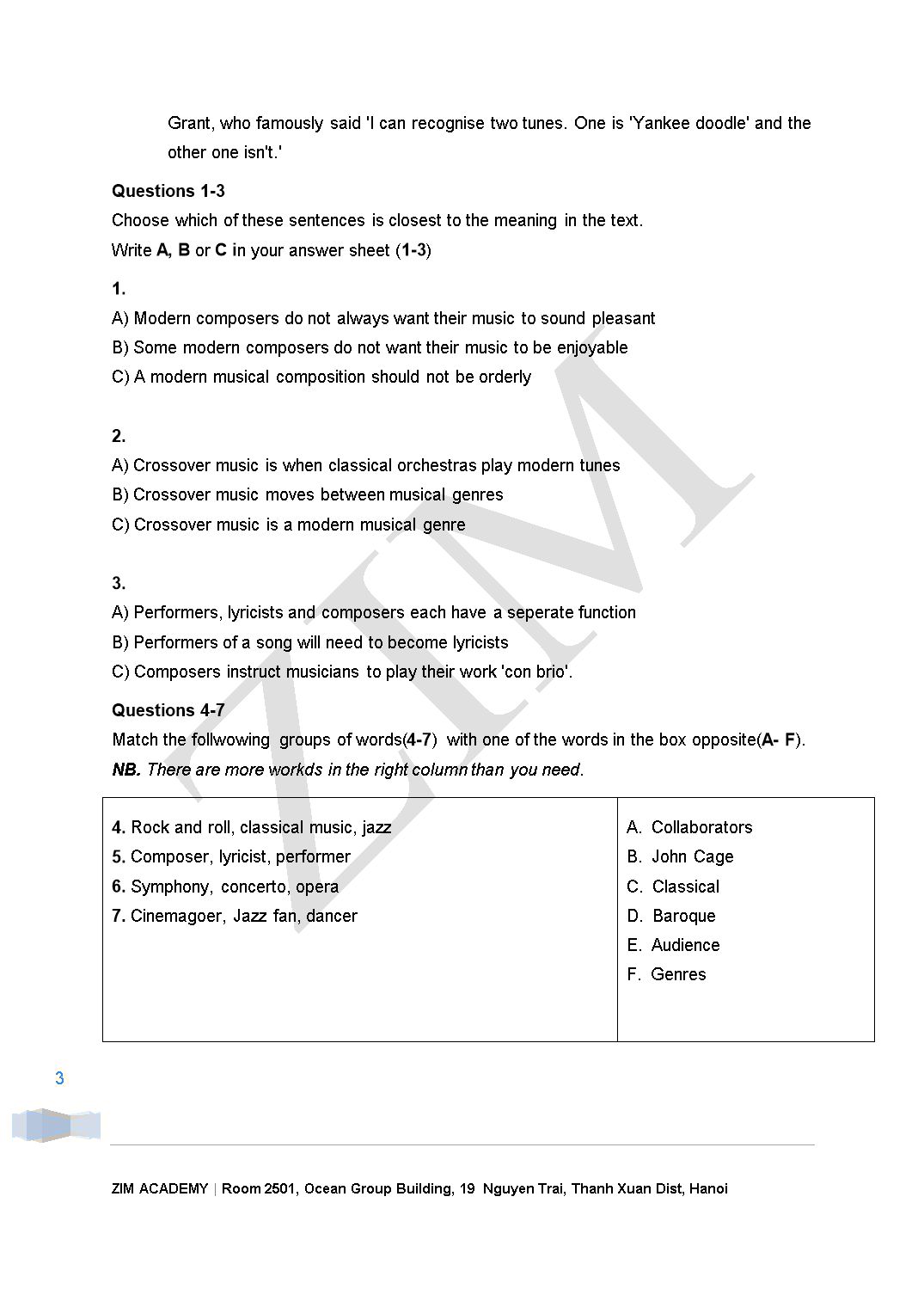
Trang 3
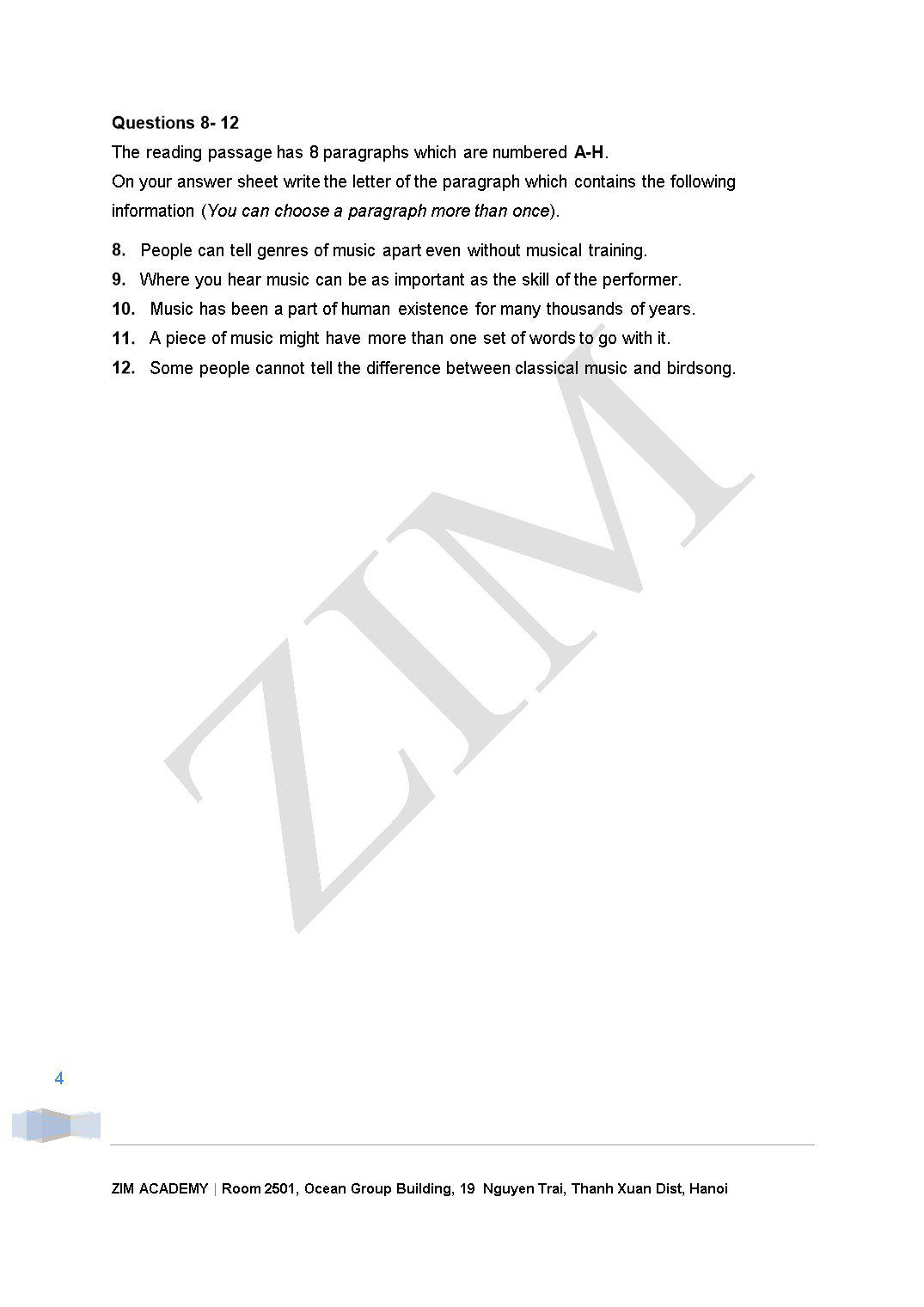
Trang 4
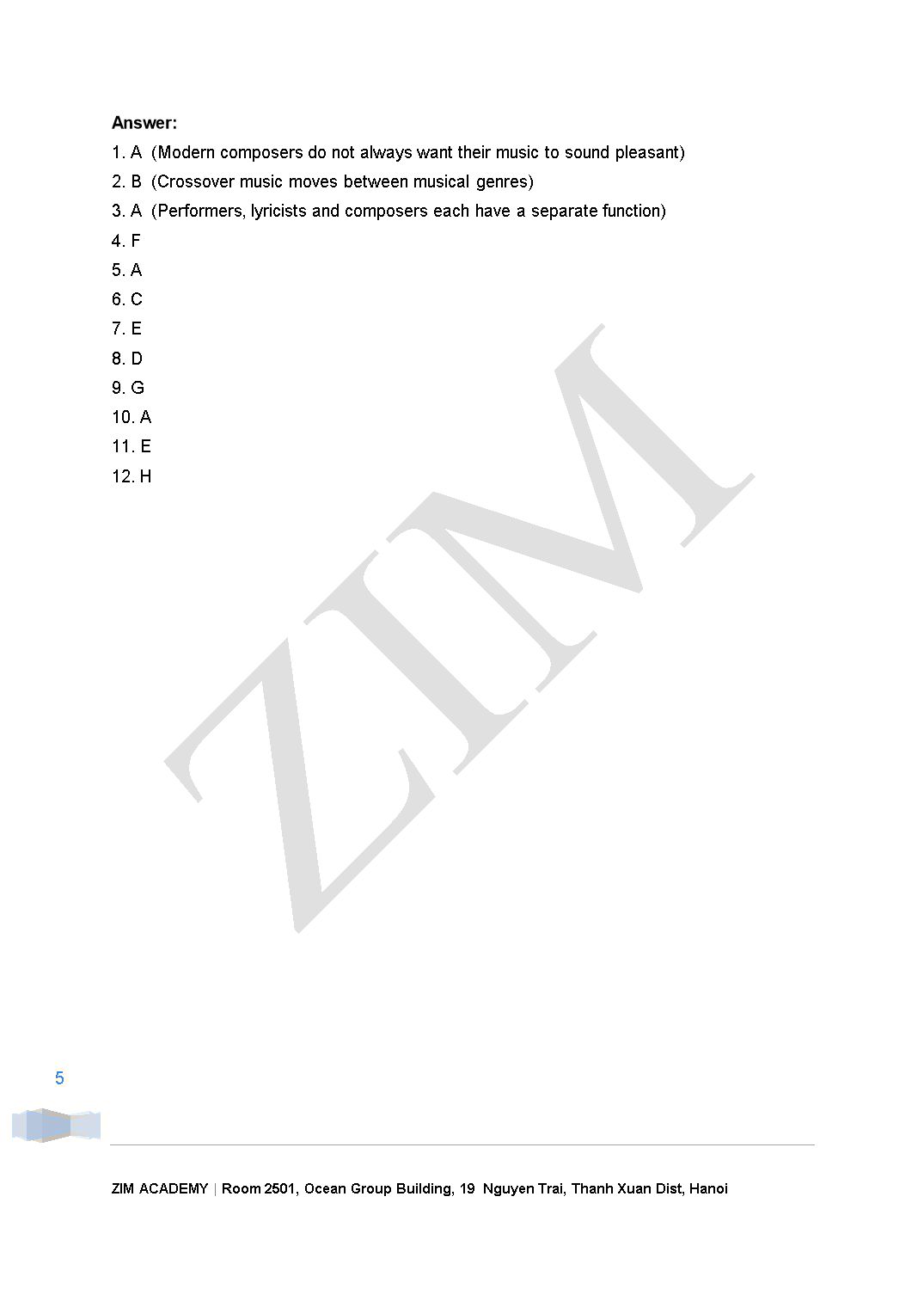
Trang 5
Tóm tắt nội dung tài liệu: Ielts Academic Reading Sample 105
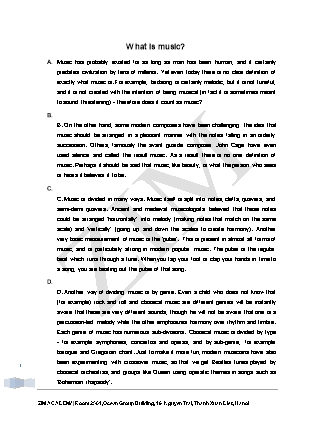
What is music? Music has probably existed for as long as man has been human, and it certainly predates civilization by tens of millenia. Yet even today there is no clear definition of exactly what music is. For example, birdsong is certainly melodic, but it is not tuneful, and it is not created with the intention of being musical (in fact it is sometimes meant to sound threatening) - therefore does it count as music? B. On the other hand, some modern composers have been challenging the idea that music should be arranged in a pleasant manner with the notes falling in an orderly succession. Others, famously the avant guarde composer John Cage have even used silence and called the result music. As a result there is no one definition of music. Perhaps it should be said that music, like beauty, is what the person who sees or hears it believes it to be. C. Music is divided in many ways. Music itself is split into notes, clefts, quavers, and semi-demi quavers. Ancient and medieval musicologists believed that these notes could be arranged 'horizontally' into melody (making notes that match on the same scale) and 'vertically' (going up and down the scales to create harmony). Another very basic measurement of music is the 'pulse'. This is present in almost all forms of music, and is particularly strong in modern popular music. The pulse is the regular beat which runs through a tune. When you tap your foot or clap your hands in time to a song, you are beating out the pulse of that song. D. Another way of dividing music is by genre. Even a child who does not know that (for example) rock and roll and classical music are different genres will be instantly aware that these are very different sounds; though he will not be aware that one is a percussion-led melody while the other emphasizes harmony over rhythm and timbre. Each genre of music has numerous sub-divisions. Classical music is divided by type - for example symphonies, concertos and operas, and by sub-genre, for example baroque and Gregorian chant. Just to make it more fun, modern musicians have also been experimenting with crossover music, so that we get Beatles tunes played by classical orchestras, and groups like Queen using operatic themes in songs such as 'Bohemian rhapsody'. E. Almost all music is a collaboration between the composer, and the performer, while song requires a lyricist to write the words as well. Sometimes old tunes are adapted for new lyrics - for example the song 'Happy Birthday' is based on a tune originally called 'Have a nice Day'. At other times a performer might produce a song in a manner which the original composer would not recognize. (A famous example is the punk rock band the Sex Pistols performing the British national anthem 'God save the Queen'.) F. This is because the composer and lyricist have to leave the performer some freedom to perform in the way that suits him or her best. While many classical compositions have notes stressing how a piece should be performed (for example a piece played 'con brio' should be light and lively) in the end, what the listener hears is the work of the performer. Jazz music has fully accepted this, and jazz performers are not only expected to put their own interpretation on a piece, but are expected to play even the same piece with some variation every time. G. Many studies of music do not take into account where the music is to be played and who the audience will be. This is a major mistake, as the audience is very much a part of the musical experience. Any jazz fan will tell you that jazz is best experienced in small smoky bars some time after midnight, while a classical fan will spend time and money making sure that the music on his stereo comes as close as possible to the sound in a large concert hall. Some music, such as dance music, is designed to be interactive, while other music is designed to remain in the background, smoothing out harsh sounds and creating a mood. This is often the case with cinema music - this powerfully changes the mood of the audience, yet remains so much in the background that many cinemagoers are unaware that the music is actually playing. H. Music is very much a part of human existence, and we are fortunate today in having music of whatever kind we choose instantly available at the touch of a button. Yet spare a thought for those who still cannot take advantage of this bounty. This includes not only the deaf, but those people who are somehow unable to understand or recognize music when they hear it. A famous example is United President Ulysses Grant, who famously said 'I can recognise two tunes. One is 'Yankee doodle' and the other one isn't.' Questions 1-3 Choose which of these sentences is closest to the meaning in the text. Write A, B or C in your answer sheet (1-3) 1. A) Modern composers do not always want their music to sound pleasant B) Some modern composers do not want their music to be enjoyable C) A modern musical composition should not be orderly 2. A) Crossover music is when classical orchestras play modern tunes B) Crossover music moves between musical genres C) Crossover music is a modern musical genre 3. A) Performers, lyricists and composers each have a seperate function B) Performers of a song will need to become lyricists C) Composers instruct musicians to play their work 'con brio'. Questions 4-7 Match the follwowing groups of words(4-7) with one of the words in the box opposite(A- F). NB. There are more workds in the right column than you need. 4. Rock and roll, classical music, jazz 5. Composer, lyricist, performer 6. Symphony, concerto, opera 7. Cinemagoer, Jazz fan, dancer A. Collaborators B. John Cage C. Classical D. Baroque E. Audience F. Genres Questions 8- 12 The reading passage has 8 paragraphs which are numbered A-H. On your answer sheet write the letter of the paragraph which contains the following information (You can choose a paragraph more than once). 8. People can tell genres of music apart even without musical training. 9. Where you hear music can be as important as the skill of the performer. 10. Music has been a part of human existence for many thousands of years. 11. A piece of music might have more than one set of words to go with it. 12. Some people cannot tell the difference between classical music and birdsong. Answer: 1. A (Modern composers do not always want their music to sound pleasant) 2. B (Crossover music moves between musical genres) 3. A (Performers, lyricists and composers each have a separate function) 4. F 5. A 6. C 7. E 8. D 9. G 10. A 11. E 12. H
File đính kèm:
 ielts_academic_reading_sample_105.doc
ielts_academic_reading_sample_105.doc

